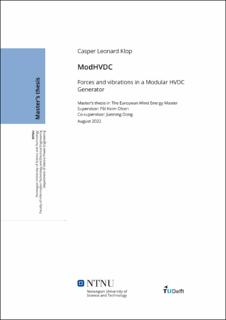| dc.description.abstract | Offshore wind energy is expected to play a major role in the upcoming energy transition. For long distances to shore, it is preferable to connect the wind farms to land by means of High-Voltage DC (HVDC) cables to reduce losses and costs. This currently poses challenges, as wind turbine generators produce variable low-voltage AC power, which needs to be converted to HVDC with heavy transformers in the wind turbine nacelle and large offshore substations. One proposed solution is to develop integrated drives which produce HVDC directly inside the nacelle, by segmenting the stator of a direct-drive generator. Each segment has its own dedicated Power Electronic (PE) converter, of which the DC output is connected in series.
This thesis studies one of the challenges of this Modular HVDC generator concept: the segmented stator generates additional vibrations in the structure, and will respond differently to the occurring forces than a stator without segmentation. The goal is to design a concept for the structure that holds the segments in place, while still allow individual modules to be replaced after failure.
As a first step, the machine design updated taking into account saturation and design limits which were neglected in previous studies. For a 10 MW Direct-Drive generator with an output DC-link voltage of 100 kV, a 10 m diameter inner-rotor Permanent Magnet Synchronous Machine with Fractional-Slot Concentrated Windings (FSCW) is designed. It has 384 slots and 320 poles, and the stator is split in 16 segments. The design is verified with Finite-Element simulations in COMSOL.
Secondly, the electromagnetic effects of the flux barriers created by the insulated gaps between the segments are analyzed analytically and numerically. The analytical model of the magnetic fields and forces agrees well with the numerical simulations in COMSOL. The FSCW result in a broad spectrum of vibrations, including the slot harmonic caused by the open slots. Segmentation of the stator has two important consequences: the addition of low spatial order radial harmonics at multiples of the number of segments, called the segment harmonics, and an increase in the cogging torque. These effects are more pronounced in the numerical simulations than in the analytical model, due to the change of the magnetic flux distribution in the segmented stator, which is neglected in the analytical calculations. Furthermore, time harmonics in the current due to the PE converters are found to significantly increase the breathing mode and torque ripple.
Thirdly, the mechanical response of two different design concepts has been analyzed by performing a modal analysis. The first design uses an interference fit, where the segments are pressed into the frame and held in position by friction. This design behaves similarly to a ring-shaped frame, and has the same eigenmodes at similar eigenfrequencies. The second design uses beams between the frame and stator to support the segments. In this case, the stiffness and structural integrity of the design is significantly reduced, leading to larger deflections and lower eigenfrequencies.
Combining the obtained forces and eigenmodes, the breathing mode, the segment harmonics and the slot harmonics are concluded to cause the strongest vibrations. The amplitude of the forces causing the first two is low, but the mechanical stiffness of these modes is low and the excitation frequency is close to the eigenfrequency. The slot harmonic is mainly important due to the low spatial order and large amplitude of the force, caused by the combination of concentrated windings and open slots. The PE converter harmonics will not lead to a stronger breathing mode vibration due to the high switching frequency of the converters, but could create resonance of the slot harmonic.
Based on these results, both designs were found to be feasible from an electromechanical perspective, as long as care is taken to mitigate the vibrations caused by the segment harmonics, and resonance of the PE converter harmonics is prevented. Due to the uncertainty of the mechanical model, experimental validation of the eigenfrequencies and the vibration levels is recommended, which can be done by using modal analysis. | |
